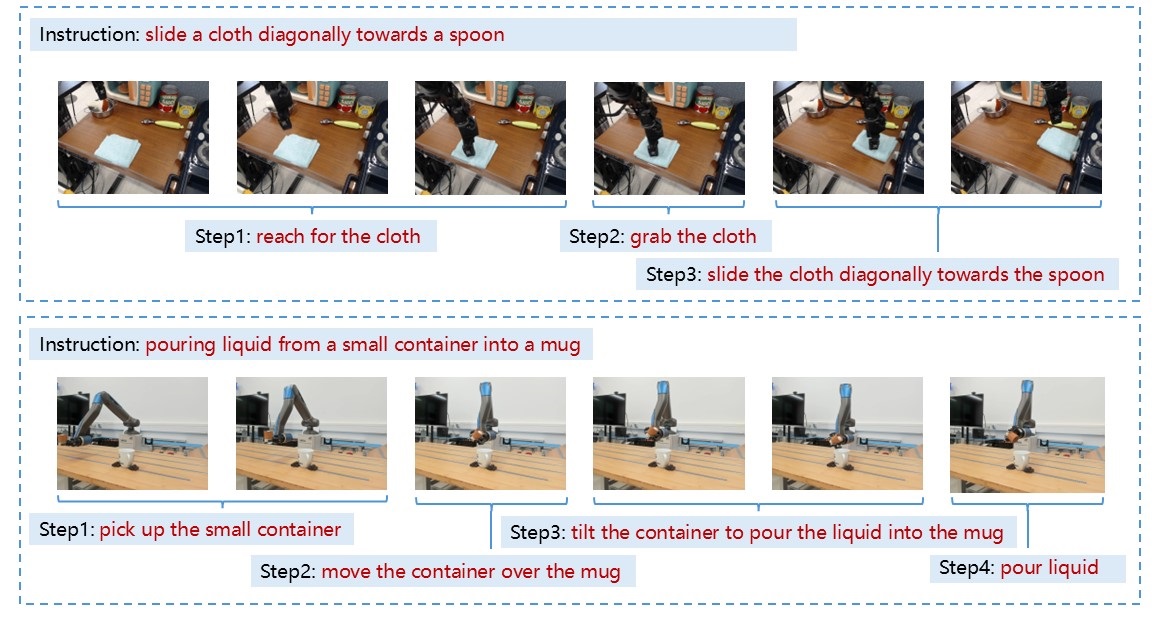The full dataset viewer is not available (click to read why). Only showing a preview of the rows.
Error code: DatasetGenerationError
Exception: ArrowCapacityError
Message: array cannot contain more than 2147483646 bytes, have 5368709120
Traceback: Traceback (most recent call last):
File "/src/services/worker/.venv/lib/python3.9/site-packages/datasets/builder.py", line 1626, in _prepare_split_single
writer.write(example, key)
File "/src/services/worker/.venv/lib/python3.9/site-packages/datasets/arrow_writer.py", line 538, in write
self.write_examples_on_file()
File "/src/services/worker/.venv/lib/python3.9/site-packages/datasets/arrow_writer.py", line 496, in write_examples_on_file
self.write_batch(batch_examples=batch_examples)
File "/src/services/worker/.venv/lib/python3.9/site-packages/datasets/arrow_writer.py", line 610, in write_batch
self.write_table(pa_table, writer_batch_size)
File "/src/services/worker/.venv/lib/python3.9/site-packages/datasets/arrow_writer.py", line 625, in write_table
pa_table = embed_table_storage(pa_table)
File "/src/services/worker/.venv/lib/python3.9/site-packages/datasets/table.py", line 2271, in embed_table_storage
arrays = [
File "/src/services/worker/.venv/lib/python3.9/site-packages/datasets/table.py", line 2272, in <listcomp>
embed_array_storage(table[name], feature) if require_storage_embed(feature) else table[name]
File "/src/services/worker/.venv/lib/python3.9/site-packages/datasets/table.py", line 1796, in wrapper
return pa.chunked_array([func(chunk, *args, **kwargs) for chunk in array.chunks])
File "/src/services/worker/.venv/lib/python3.9/site-packages/datasets/table.py", line 1796, in <listcomp>
return pa.chunked_array([func(chunk, *args, **kwargs) for chunk in array.chunks])
File "/src/services/worker/.venv/lib/python3.9/site-packages/datasets/table.py", line 2141, in embed_array_storage
return feature.embed_storage(array)
File "/src/services/worker/.venv/lib/python3.9/site-packages/datasets/features/image.py", line 271, in embed_storage
bytes_array = pa.array(
File "pyarrow/array.pxi", line 343, in pyarrow.lib.array
File "pyarrow/array.pxi", line 42, in pyarrow.lib._sequence_to_array
File "pyarrow/error.pxi", line 154, in pyarrow.lib.pyarrow_internal_check_status
File "pyarrow/error.pxi", line 91, in pyarrow.lib.check_status
pyarrow.lib.ArrowCapacityError: array cannot contain more than 2147483646 bytes, have 5368709120
During handling of the above exception, another exception occurred:
Traceback (most recent call last):
File "/src/services/worker/.venv/lib/python3.9/site-packages/datasets/builder.py", line 1635, in _prepare_split_single
num_examples, num_bytes = writer.finalize()
File "/src/services/worker/.venv/lib/python3.9/site-packages/datasets/arrow_writer.py", line 637, in finalize
self.write_examples_on_file()
File "/src/services/worker/.venv/lib/python3.9/site-packages/datasets/arrow_writer.py", line 496, in write_examples_on_file
self.write_batch(batch_examples=batch_examples)
File "/src/services/worker/.venv/lib/python3.9/site-packages/datasets/arrow_writer.py", line 610, in write_batch
self.write_table(pa_table, writer_batch_size)
File "/src/services/worker/.venv/lib/python3.9/site-packages/datasets/arrow_writer.py", line 625, in write_table
pa_table = embed_table_storage(pa_table)
File "/src/services/worker/.venv/lib/python3.9/site-packages/datasets/table.py", line 2271, in embed_table_storage
arrays = [
File "/src/services/worker/.venv/lib/python3.9/site-packages/datasets/table.py", line 2272, in <listcomp>
embed_array_storage(table[name], feature) if require_storage_embed(feature) else table[name]
File "/src/services/worker/.venv/lib/python3.9/site-packages/datasets/table.py", line 1796, in wrapper
return pa.chunked_array([func(chunk, *args, **kwargs) for chunk in array.chunks])
File "/src/services/worker/.venv/lib/python3.9/site-packages/datasets/table.py", line 1796, in <listcomp>
return pa.chunked_array([func(chunk, *args, **kwargs) for chunk in array.chunks])
File "/src/services/worker/.venv/lib/python3.9/site-packages/datasets/table.py", line 2141, in embed_array_storage
return feature.embed_storage(array)
File "/src/services/worker/.venv/lib/python3.9/site-packages/datasets/features/image.py", line 271, in embed_storage
bytes_array = pa.array(
File "pyarrow/array.pxi", line 343, in pyarrow.lib.array
File "pyarrow/array.pxi", line 42, in pyarrow.lib._sequence_to_array
File "pyarrow/error.pxi", line 154, in pyarrow.lib.pyarrow_internal_check_status
File "pyarrow/error.pxi", line 91, in pyarrow.lib.check_status
pyarrow.lib.ArrowCapacityError: array cannot contain more than 2147483646 bytes, have 5368709120
The above exception was the direct cause of the following exception:
Traceback (most recent call last):
File "/src/services/worker/src/worker/job_runners/config/parquet_and_info.py", line 1433, in compute_config_parquet_and_info_response
parquet_operations, partial, estimated_dataset_info = stream_convert_to_parquet(
File "/src/services/worker/src/worker/job_runners/config/parquet_and_info.py", line 989, in stream_convert_to_parquet
builder._prepare_split(
File "/src/services/worker/.venv/lib/python3.9/site-packages/datasets/builder.py", line 1487, in _prepare_split
for job_id, done, content in self._prepare_split_single(
File "/src/services/worker/.venv/lib/python3.9/site-packages/datasets/builder.py", line 1644, in _prepare_split_single
raise DatasetGenerationError("An error occurred while generating the dataset") from e
datasets.exceptions.DatasetGenerationError: An error occurred while generating the datasetNeed help to make the dataset viewer work? Make sure to review how to configure the dataset viewer, and open a discussion for direct support.
image
image |
|---|
ShareRobot Dataset
ShareRobot, a high-quality heterogeneous dataset that labels multi-dimensional information, including task planning, object affordance, and end-effector trajectory, effectively enhancing various robotic capabilities.
Overview of ShareRobot Dataset
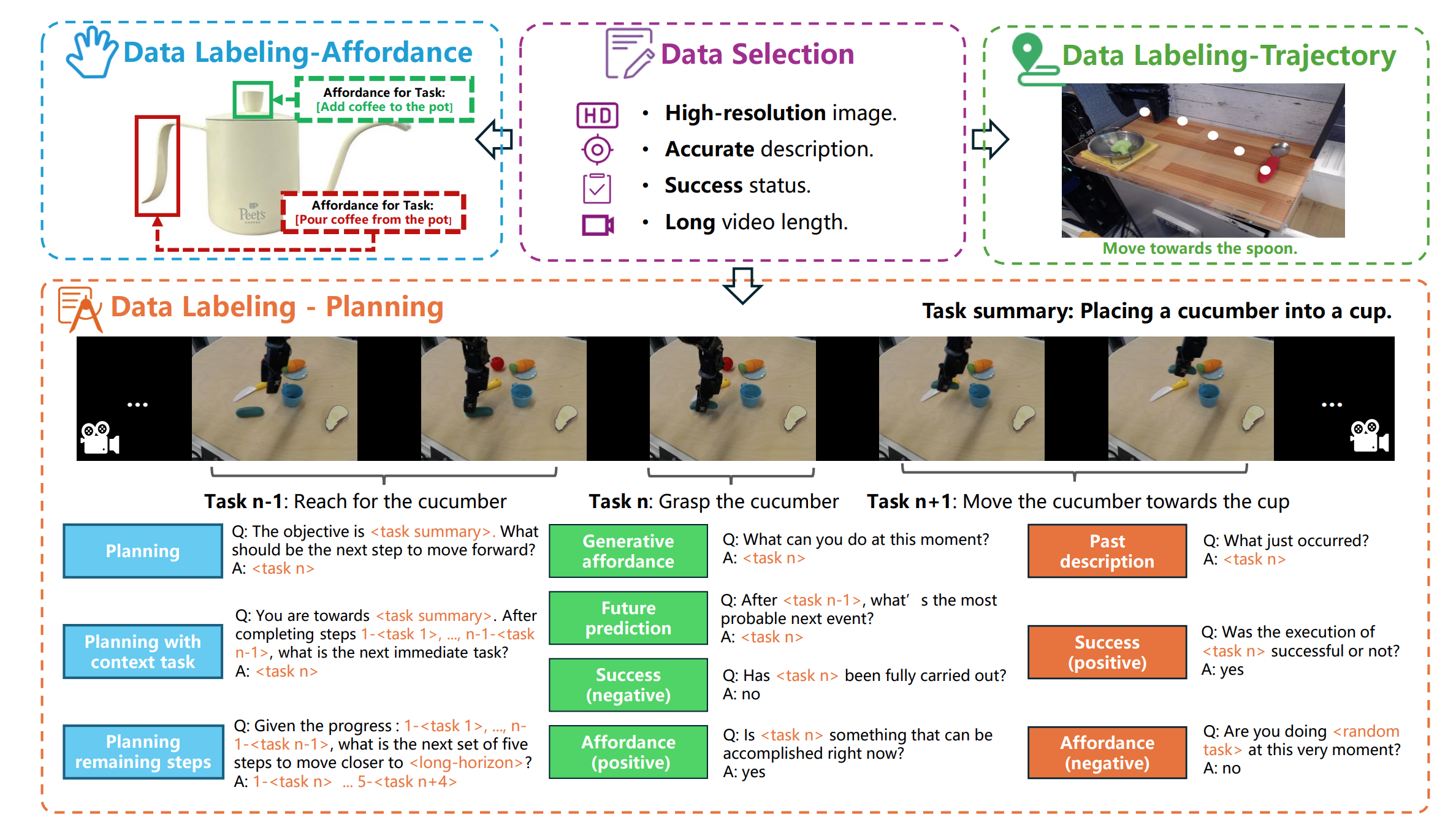 For planning, we have 51,403 episodes and each with 30 frames. In the process of data generation, we design 5 different templates for each of the 10 question types in RoboVQA [1]. In the process of data generation, we randomly select 2 templates of each question type to generate question-answer pairs for every instance. This process transforms 51,403 instances into 1,027,990 question-answer pairs, with annotators monitoring data generation to maintain the dataset’s integrity.
For planning, we have 51,403 episodes and each with 30 frames. In the process of data generation, we design 5 different templates for each of the 10 question types in RoboVQA [1]. In the process of data generation, we randomly select 2 templates of each question type to generate question-answer pairs for every instance. This process transforms 51,403 instances into 1,027,990 question-answer pairs, with annotators monitoring data generation to maintain the dataset’s integrity.
For Affordance, we have 6,522 images and each with affordance areas aligned with an instruction.
For Trajectory, we have 6,870 images and each with at least 3 {x, y} coordinates aligned with an instruction.
Dataset Sources
ShareRobot dataset contains 23 original datasets from Open X-Embodiment dataset [2], 12 embodiments and 107 types of atomic tasks.
Raw Dataset for Planning
| Raw Dataset | Number of Raws |
|---|---|
| nyu_door_opening_surprising_effectiveness | 421 |
| bridge | 15738 |
| dlr_edan_shared_control_converted_externally_to_rlds | 63 |
| utokyo_xarm_pick_and_place_converted_externally_to_rlds | 92 |
| cmu_stretch | 10 |
| asu_table_top_converted_externally_to_rlds | 109 |
| dlr_sara_pour_converted_externally_to_rlds | 51 |
| utokyo_xarm_bimanual_converted_externally_to_rlds | 27 |
| robo_set | 18164 |
| dobbe | 5200 |
| berkeley_autolab_ur5 | 882 |
| qut_dexterous_manpulation | 192 |
| aloha_mobile | 264 |
| dlr_sara_grid_clamp_converted_externally_to_rlds | 40 |
| ucsd_pick_and_place_dataset_converted_externally_to_rlds | 569 |
| ucsd_kitchen_dataset_converted_externally_to_rlds | 39 |
| jaco_play | 956 |
| utokyo_pr2_opening_fridge_converted_externally_to_rlds | 64 |
| conq_hose_manipulation | 56 |
| fmb | 7836 |
| plex_robosuite | 398 |
| utokyo_pr2_tabletop_manipulation_converted_externally_to_rlds | 189 |
| viola | 44 |
Raw Dataset for Affordance
| Raw Dataset | Number of Raws |
|---|---|
| utokyo_pr2_tabletop_manipulation_converted_externally_to_rlds | 24 |
| utokyo_xarm_pick_and_place_converted_externally_to_rlds | 23 |
| ucsd_kitchen_dataset_converted_externally_to_rlds | 10 |
| ucsd_pick_and_place_dataset_converted_externally_to_rlds | 112 |
| nyu_door_opening_surprising_effectiveness | 85 |
| jaco_play | 171 |
| bridge | 2610 |
| utokyo_pr2_opening_fridge_converted_externally_to_rlds | 12 |
| asu_table_top_converted_externally_to_rlds | 24 |
| viola | 1 |
| berkeley_autolab_ur5 | 122 |
| aloha_mobile | 23 |
| conq_hose_manipulation | 1 |
| dobbe | 717 |
| fmb | 561 |
| plex_robosuite | 13 |
| qut_dexterous_manpulation | 16 |
| robo_set | 1979 |
| dlr_edan_shared_control_converted_externally_to_rlds | 18 |
| Summary | 6522 |
Raw Dataset for Trajectory
| Raw Dataset | Number of Raws |
|---|---|
| utokyo_pr2_tabletop_manipulation_converted_externally_to_rlds | 35 |
| utokyo_xarm_pick_and_place_converted_externally_to_rlds | 36 |
| ucsd_kitchen_dataset_converted_externally_to_rlds | 19 |
| dlr_sara_grid_clamp_converted_externally_to_rlds | 1 |
| ucsd_pick_and_place_dataset_converted_externally_to_rlds | 109 |
| nyu_door_opening_surprising_effectiveness | 74 |
| jaco_play | 175 |
| utokyo_xarm_bimanual_converted_externally_to_rlds | 7 |
| bridge | 2986 |
| utokyo_pr2_opening_fridge_converted_externally_to_rlds | 12 |
| asu_table_top_converted_externally_to_rlds | 22 |
| berkeley_autolab_ur5 | 164 |
| dobbe | 759 |
| fmb | 48 |
| qut_dexterous_manpulation | 29 |
| robo_set | 2374 |
| dlr_sara_pour_converted_externally_to_rlds | 3 |
| dlr_edan_shared_control_converted_externally_to_rlds | 17 |
| Summary | 6870 |
Data Format
Planning
{
"id"{
"id": 0,
"task": "Future_Prediction_Task",
"selected_step": 3,
"conversations": [
{
"from": "human",
"value": "<image 0-25> After <move the grasped banana towards the mug>, what's the most probable next event?"
},
{
"from": "gpt",
"value": "<place the banana into the mug>"
}
],
"image": [
"/path/to/image_0-25"
]
}
}
Affordance
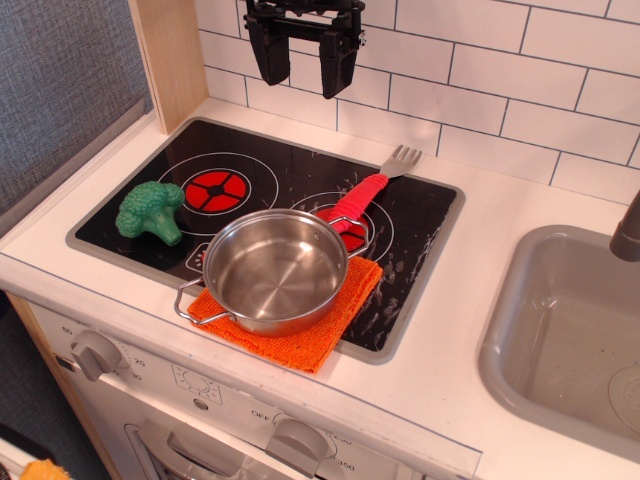
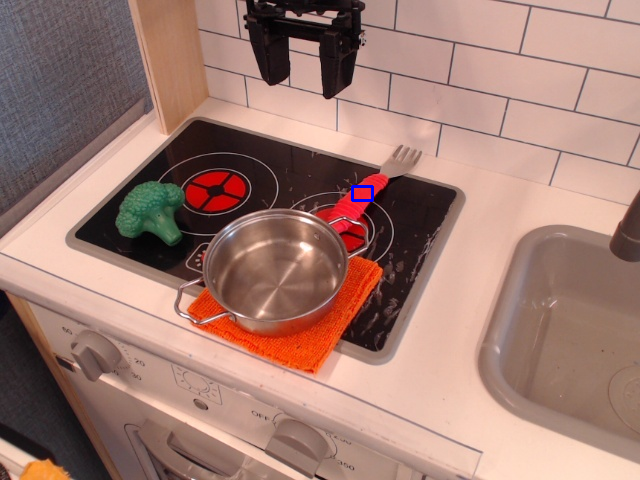
{
"id": 2486,
"meta_data": {
"original_dataset": "bridge",
"original_width": 640,
"original_height": 480
},
"instruction": "place the red fork to the left of the left burner",
"affordance": {
"x": 352.87425387858815,
"y": 186.47871614766484,
"width": 19.296008229513156,
"height": 14.472006172134865
}
Visualize Code
import json
import os
import cv2
import numpy as np
img_dir = '/path/to/your/original/images/dir'
affordance_json = '/path/to/your/affordances/json'
output_img_dir = '/path/to/your/visualized/images/dir'
with open(affordance_json, 'r') as f:
data = json.load(f)
for item in data:
filepath = os.path.join(img_dir, item['id'])
image = cv2.imread(filepath)
color = (255, 0, 0)
thickness = 2
x_min,y_min = item['affordance']['x'], item['affordance']['y']
x_max,y_max = item['affordance']['x']+item['affordance']['width'], item['affordance']['y']+item['affordance']['height']
# 定义矩形的四个顶点坐标
pts = np.array([
[x_min, y_min], # 左上角
[x_max, y_min], # 右上角
[x_max, y_max], # 右下角
[x_min, y_max] # 左下角
], dtype=np.float32)
# 绘制矩形框
cv2.polylines(image, [pts.astype(int)], isClosed=True, color=color, thickness=thickness)
# 获取相对路径并拼接目标路径
relative_path = os.path.relpath(filepath, img_dir) # 获取相对于 img_dir 的相对路径
output_img_path = os.path.join(output_img_dir, relative_path) # 拼接目标路径
# 创建目标文件夹
output_directory = os.path.dirname(output_img_path)
if not os.path.exists(output_directory):
os.makedirs(output_directory)
# 打印调试信息
print(f"Input filepath: {filepath}")
print(f"Output image path: {output_img_path}")
print(f"Output directory: {output_directory}")
# 保存图像
cv2.imwrite(output_img_path, image)
Trajectory
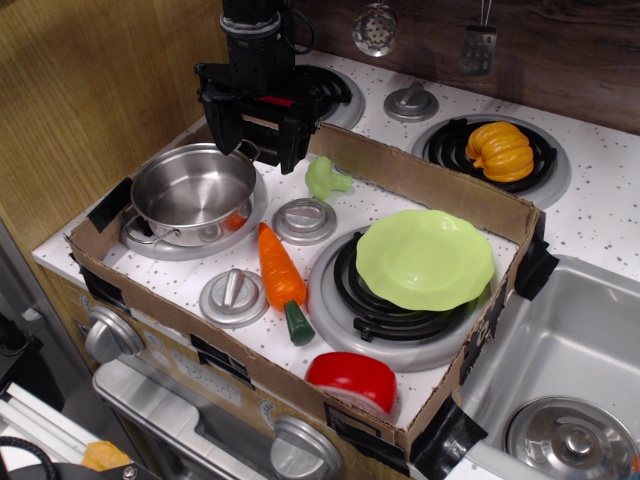
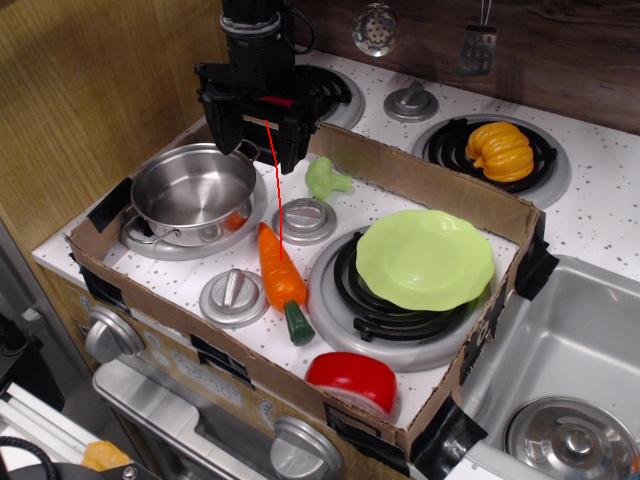
{
"id": 456,
"meta_data": {
"original_dataset": "bridge",
"original_width": 640,
"original_height": 480
},
"instruction": "reach for the carrot",
"points": [
[
265.45454545454544,
120.0
],
[
275.1515151515152,
162.42424242424244
],
[
280.0,
213.33333333333331
],
[
280.0,
259.3939393939394
]
]
},
Visualize Code
import json
import os
from PIL import Image, ImageDraw
trajectory_final = '/path/to/your/trajectory_json'
img_dir = '/path/to/your/original/images/dir'
output_img_dir = '/path/to/your/visualzed/images/dir'
with open(trajectory_final, 'r') as f:
data = json.load(f)
for item in data:
filepath = os.path.join(img_dir, item['id'])
points = item['points']
image = Image.open(filepath).convert("RGB") # 确保图像是 RGB 模式
draw = ImageDraw.Draw(image) # 创建绘图对象
# 定义颜色和线宽
color = (255, 0, 0) # 红色 (RGB 格式)
thickness = 2
scaled_points = [
(point[0], point[1])
for point in points
]
# 按照顺序连接相邻的点
for i in range(len(scaled_points) - 1):
draw.line([scaled_points[i], scaled_points[i + 1]], fill=color, width=thickness)
# 获取相对路径并拼接目标路径
relative_path = os.path.relpath(filepath, img_dir)
output_img_path = os.path.join(output_img_dir, relative_path)
# 创建目标文件夹
output_directory = os.path.dirname(output_img_path)
if not os.path.exists(output_directory):
os.makedirs(output_directory)
# 打印调试信息
print(f"Input filepath: {filepath}")
print(f"Output image path: {output_img_path}")
print(f"Output directory: {output_directory}")
# 保存图像
image.save(output_img_path)
Evaluation
Reference
[1] Pierre Sermanet, Tianli Ding, Jeffrey Zhao, Fei Xia, Debidatta Dwibedi, Keerthana Gopalakrishnan, Christine Chan,Gabriel Dulac-Arnold, Sharath Maddineni, Nikhil J Joshi,et al. Robovqa: Multimodal long-horizon reasoning forrobotics. In ICRA, pages 645–652, 2024.
[2] Abby O’Neill, Abdul Rehman, Abhinav Gupta, AbhiramMaddukuri, Abhishek Gupta, Abhishek Padalkar, AbrahamLee, Acorn Pooley, Agrim Gupta, Ajay Mandlekar, et al.Open x-embodiment: Robotic learning datasets and rt-xmodels. arXiv preprint arXiv:2310.08864, 2023.
Citation
@article{ji2025robobrain,
title={RoboBrain: A Unified Brain Model for Robotic Manipulation from Abstract to Concrete},
author={Ji, Yuheng and Tan, Huajie and Shi, Jiayu and Hao, Xiaoshuai and Zhang, Yuan and Zhang, Hengyuan and Wang, Pengwei and Zhao, Mengdi and Mu, Yao and An, Pengju and others},
journal={arXiv preprint arXiv:2502.21257},
year={2025}
}
- Downloads last month
- 182,224

